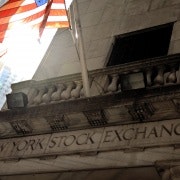Five years on, big US banks are back
Speaking at the Economic Club of New York in October 2008, Federal Reserve chairman Ben Bernanke alluded to the fact that the US banking system had become far more concentrated than just a few weeks earlier.
Wells Fargo had swallowed Wachovia, JPMorgan had been given both Bear Stearns and Washington Mutual. Bank of America was choking on Countrywide and struggling to absorb Merrill Lynch while Citi was struggling to just survive. Still, that concentration was not the biggest problem of the moment, he said in an obvious understatement.
At the end of 2007, the financial sector had accounted for 17.6 per cent of the S&P 500 index by market cap but by the next year, that had dropped to 13.2 per cent. Today, at 16.4 per cent, financial companies led by the banks are clawing their way back to a larger share once more – they are regaining clout.
As the fifth anniversary of the financial meltdown approaches, it is evident that the apparent strength of the banks at that time was at least partly an illusion, since that strength was built on leverage that is never a stable foundation. Today, five years on, it is clear that the banks are stronger and more profitable than back then.
The financial sector is expected to increase earnings by 13 per cent this year, the highest pace of any sector with only telecoms services growing at an equivalent pace, according to Merrill Lynch. The banks’ recovery can only be a good thing.
Today, there is far less leverage. The off-balance-sheet units, such as the so-called structured investment vehicles, are a thing of the past. Moreover, the banks can no longer dictate the rules by which they are governed.
In recent years, “the rules were warped to give the banks what they wanted – it was all about maximising leverage,” says one former New York Fed official. “The regulators were not ready to stop it.”
The last time the banks were almost undone more than 20 years ago, the regulators including Paul Volcker and Gerald Corrigan were confident enough to dictate to ailing institutions such as Citigroup, forcing them to take measures such as cutting their dividends to preserve capital. When Citi’s then chief executive, John Reed, balked, Corrigan famously told Reed he would have the same conversation “with your successor”.
Now the regulators have regained their confidence and have the evidence of the debacle of the 2008 crisis to give their demands undeniable legitimacy.
Risk management has also been (mostly) improved as executives have learnt that often there is no such thing as the intrinsic value of any security – it all depends on liquidity. As a result, the banks are stress-testing their portfolios more and using more extreme scenarios in doing so, replacing their most illiquid securities with easier to trade stuff, maintaining larger capital buffers and managing the tenor of their exposures more proactively.
It is also true that the entire banking system has become far more concentrated – and indeed it is precisely that concentration that has allowed the banks to be so profitable.
The combination of quantitative easing, which has flooded the world with liquidity and given the banks generous gains on bond holdings, and the lack of competition has swelled the bottom line.
There are some concerns. The only group that has been a bigger beneficiary of the Fed’s munificence is arguably the non-banks that do not have the constraints of deposit-taking institutions and can operate with leverage. They charge more and, often when they lend, demand more upside, whether in the form of equity warrants or a percentage of cash flows.
Moreover, it is not clear whether there is the right balance between minimising systemic risk and giving incentives to the banks to lend appropriately, with some bankers saying that rules on capital and leverage discourage many types of lending including project and infrastructure finance.
Hopefully the banks understand that it is partly the generosity and the forbearance of the Fed that makes them look so good these days. Still, because these benign conditions will surely pass and because the institutional memory of the banks is short – and becoming shorter as so many people leave the industry – it is hard not to be cynical.
Copyright The Financial Times Limited 2013















